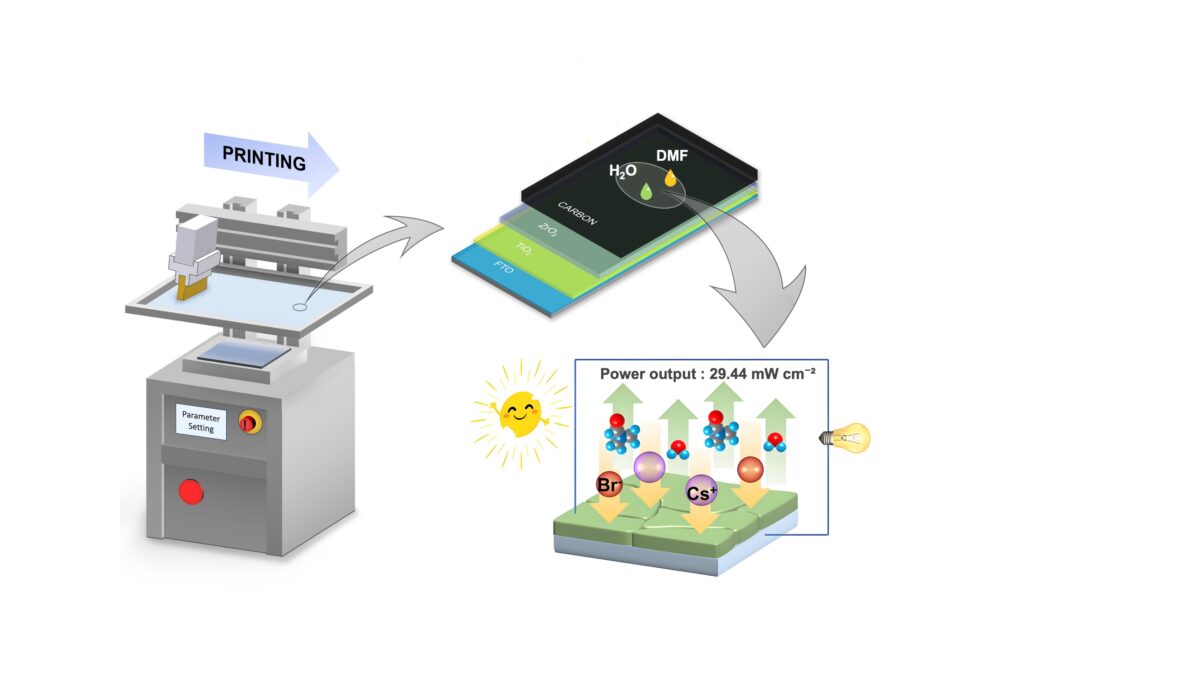Industry news
Chinese scientists improve carbon perovskite solar cell performance via dual-solvent process
A team of researchers in China has demonstrated a novel dual-solvent process in 4-terminal carbon CsPbBr3 perovskite solar cells that achieve 10.18% power conversion efficiency. They have also built a large area 17.88 cm2 device achieving an 8.72% efficiency while retaining 93.2% of the initial performance after 1,000 hours of operation at 150 C.

Researchers at the East China University of Science and Technology, have developed a novel dual-solvent manufacturing approach for perovskite solar cells and modules in an effort to improve their stability.
“Our research innovatively employed a dual-solvent engineering approach within a two-step process to elevate the power conversion efficiency of printable mesoscopic CsPbBr3-based perovskite solar cells to a record-breaking 10.18% efficiency,” corresponding author, Wenjun Wu, told pv magazine. “Furthermore, by integrating a four-terminal reflective device, we successfully boosted the output power to 29.44 mW cm-2.”
The researchers noted that previous studies established water as a suitable solvent in forming CsPbBr3 perovskite based on the appropriateness of its donor number and dielectric constant but also that it had shortcomings at the level of film quality and device performance. They used density functional theory (DFT) calculations and Tyndall effect analysis to address the limitations. Their novel dual-solvent engineering strategy incorporated N-dimethylformamide (DMF) as a co-solvent.
“By carefully selecting solvents with enhanced donor numbers and dielectric constants, the surface Br/Pb ratio of CsPbBr3 was effectively modulated, inducing p-type transition, and suppressing defect formation within the perovskite film,” said the researchers.
Screen printing was used to fabricate the all-inorganic carbon-based mesoscopic perovskite solar cells. Their performance was compared to that of reference cells made with a more conventional aqueous process.
The technology was demonstrated in an all-inorganic carbon-based printable mesoscopic perovskite solar cell that achieved a record power conversion efficiency of 10.18%. Furthermore, the scientists built a large-area device of 17.88 cm2 that achieved an efficiency of 8.72%.
The treatment enabled “remarkable improvements” in carrier dynamics, reduced defect densities, and enhanced device performance, according to the research team. The stability tests showed that 93.2% of the initial efficiency was retained after 1,000 hours of operation at 150 C.
To further enhance the power output, the scientists integrated the 4-terminal cell with a mirror-concentrator device to achieve 29.44 mW cm2. “Our findings establish a promising pathway towards high-performance and stable all-inorganic perovskite solar cells suitable for large-scale applications,” concluded the team.
Its work is described in detail in “Achieving unprecedented power-output in 4-terminal mirror-symmetrical printable carbon CsPbBr3 solar cells through dual-solvent engineering,” recently published in Energy & Environmental Science.
“In the future, we plan to continue enhancing the photoelectric conversion characteristics of the devices through optimization of the crystallization process, screening of passivation systems, and the development of efficient incident light collection and utilization devices. We also aim to explore applications in large-area devices,” Wu said, referring to the future direction of the research work.
Original from: https://www.pv-magazine.com/2025/04/08/chinese-scientists-improve-carbon-perovskite-solar-cell-performance-via-dual-solvent-process/
RELATED NEWS
CATEGORIES
LATEST NEWS
CONTACT US
Contact: Mr.Calway Chow
Phone: 0086-18262684986
E-mail: info@flagsun.com
Whatsapp:0086-13814572602
Add: No.119 Yanshan west Road,Chengxiang Town,Taicang City,Jiangsu ,China